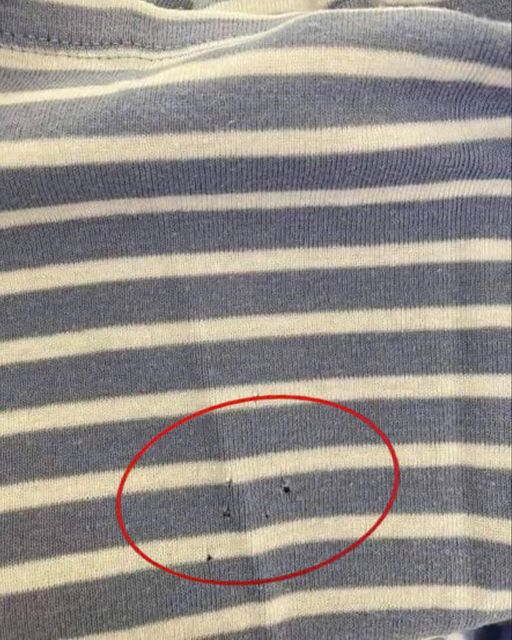ADVERTISEMENT
4. Button or Zipper Damage
- Appearance: Small holes near or around the buttonholes or zipper area of your clothing.
- Cause: Buttons or zippers that aren’t securely sewn can tug at the fabric, causing small tears or holes. The friction caused by zippers or even poorly aligned buttons can weaken the fabric.
- Solution: Check your buttons and zippers before washing or wearing clothing. Reinforce or replace any loose buttons or broken zippers. If you find holes near these areas, reinforce them with extra stitching or add a fabric patch for support.
5. Teeth or Pet Damage
- Appearance: Irregular, jagged holes, often in places where pets might chew or bite.
- Cause: Cats, dogs, and other pets often scratch or chew on fabrics. If you spot holes in your clothes near the hem or in the sleeves, it could be due to your furry friend’s curiosity.
- Solution: Keep clothing out of reach of pets when possible. If the hole is caused by your pet, it’s best to either repair it with fabric glue or use an iron-on patch. If the hole is large, you may want to consider consulting a tailor for a professional repair.
6. Abrasion from Objects
- Appearance: Small, jagged holes along the fabric where rubbing or friction has occurred, often on the inner thighs of pants or at the wrists of shirts.
- Cause: This damage is commonly caused by rubbing against rough surfaces or objects. For example, jeans that rub against the inside of a car seat, shoes that scrape against the fabric, or wearing bags with rough straps can cause fabric to wear thin.
- Solution: Pay attention to high-contact areas of your clothing. If you know certain items tend to cause wear, apply patches or reinforcements to those areas. For existing holes, a fabric patch or creative stitching may help extend the life of your garment.
How to Repair Holes in Your Clothes
Once you’ve identified the cause of the holes, the next step is repairing them. Here are some ways to mend those pesky holes:
1. Sewing the Hole
If the hole is small and the fabric is in good condition, sewing is often the easiest and most effective solution. Use a needle and matching thread to sew the hole closed with small, neat stitches. You can even use a sewing machine for a quicker repair.
2. Iron-On Patches
For larger holes or if you’re looking for a quick fix, an iron-on patch can be a great option. Simply place the patch over the hole, apply heat with an iron, and the patch will adhere to the fabric. These patches come in various colors and textures, so they can even be a fashionable way to add a unique touch to your garment.
3. Darning
Darning is a technique used to repair holes, particularly in knitted or woven fabrics. It involves weaving a new thread back and forth over the damaged area. This technique works well on wool, cotton, and some synthetics.
4. Fabric Glue
For delicate fabrics or items you don’t want to sew, fabric glue can be a good alternative. Apply a small amount of glue around the edges of the hole, press the fabric together, and let it dry completely. This is ideal for small rips or tears.
5. Patchwork
If you’re feeling creative, you can add a decorative patch over the hole. This not only repairs the fabric but also adds a unique touch to your clothing. You can find patches with fun designs or even create your own using fabric scraps.
Preventing Holes in the Future
Once you’ve tackled the holes in your clothes, you’ll want to take steps to prevent future damage. Here are a few tips to keep your clothes in tip-top shape:
- Wash with Care: Use gentle laundry cycles, and avoid washing clothes with rougher items like jeans or towels that could cause abrasion. Consider using a laundry bag for delicate fabrics.
- Store Clothes Properly: Keep clothes in airtight containers or garment bags to protect them from pests like moths. Store seasonal items in a cool, dry place.
- Handle with Care: Pay attention to areas that are prone to damage, such as zippers, buttons, or areas that rub against furniture or bags. A little attention can go a long way in extending the life of your clothes.
- Regularly Check for Damage: Inspect your clothes before washing to ensure that buttons are secure, zippers are functioning, and there are no hidden tears that could get worse with wear.
Conclusion
While holes in clothing can be frustrating, they don’t always mean the end of your favorite garments. By understanding the cause of the holes and taking steps to repair them, you can extend the life of your clothes and even add a personal touch to your wardrobe with patches or creative mending. With a little care and attention, you can prevent further damage and keep your clothes looking fresh for years to come.
ADVERTISEMENT
